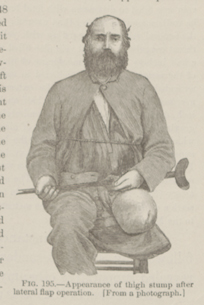Title: McConkey, Alexander
Source text: The Medical and Surgical History of the War of the Rebellion. (1861-65.), Part 3, Volume 2 (Washington, DC: Government Printing Office, 1883), 289.
Civil War Washington ID: med.d2e12592
TEI/XML: med.d2e12592.xml
CASE 468.—Private Alexander McConkey, Co. D, 63d Pennsylvania, aged 48 years, was wounded at the Wilderness, May 5, 1864, by a conoidal ball, which entered on the inner condyle of the left knee, passed through the joint, and made its exit on the opposite side. He was conveyed to Washington, and admitted into the Harewood Hospital on May 14th. Surgeon R. B. Bontecou, U. S. V., furnishes the following notes of the case: "An examination of the injury was immediately made; the soft parts around the wound were found much inflamed and the joint œdematous. His general condition being good, it was decided to amputate without delay, and the patient being chloroformed, Surgeon Bontecou removed the thigh in the lower third by the lateral flap operation. The stump healed favorably, the ligatures came away on the eighth day, and the patient progressed well on a supporting diet until, July 29th, he had so far recovered as to be about on crutches, when he accidentally fell, injuring the stump, which became inflamed; alcohol and water dressings were applied. On August 4th, an abscess was opened, which discharged about four ounces of pus. 5th, he had a severe attack of diarrhœa, which was checked by proper treatment. 30th, condition very good; a small sinus still exists, owing to some necrosed bone." He was transferred to Pittsburg, April 3, 1865, and admitted into hospital there. The wound had entirely healed, and he was discharged May 19, 1865. He was pensioned, and died May 15, 1873; the cause of death is not satisfactorily given. The pathological specimen, showing the bones of the left knee, with the articular extremity of the femur shattered (No. 3066, Sect. I, A. M. M., Cat., 1866, p. 338), was contributed by the operator, who also furnished a photograph of the stump, which is copied in the adjoining wood-cut, FIG. 195.
